3D Printing of pH Indicator Auxetic Hydrogel Skin Wound Dressing
Abstract
1. Introduction
2. Results and Discussion
2.1. Optical Characterization of the 3D Printed HEMA/PEGDA/TPO/AA Hydrogels
2.2. Shrinkage Behavior
2.3. Fourier Transform Infrared Spectroscopy (FTIR) Analysis
2.4. pH Characterization of the 3D Printed HEMA/PEGDA/TPO/AA Hydrogels
2.5. Weight Loss (Degradation) of 3D Printed HEMA/PEGDA/TPO/AA Hydrogels
2.6. Swelling Behavior, Porosity and Surface Wettability of 3D Printed HEMA/PEGDA/TPO/AA Hydrogels
2.7. Mechanical Property Analysis of 3D Printed HEMA/PEGDA/TPO/AA Hydrogels
2.7.1. Effect of Resin Composition on the Mechanical Properties
2.7.2. Mechanical Response of the Auxetic Hydrogel Wound Dressing
2.8. Adhesion Capability of 3D Printed HEMA/PEGDA/TPO/AA Hydrogels
3. Experimental
3.1. Materials
3.2. Hydrogel Resin Preparation and PBS Solution
3.3. Preparation of CAD Models
3.4. 3D Printing Procedures
3.5. Post-Processing
3.6. Characterization
3.6.1. Optical Spectroscopy
3.6.2. Shrinkage Behavior
3.6.3. Swelling Capacity
3.6.4. Surface Wettability
3.6.5. Weight Loss (Degradation Rate)
3.6.6. Porosity
3.6.7. Tensile Tests
3.6.8. Adhesion Tests
4. Conclusions
Author Contributions
Funding
Institutional Review Board Statement
Informed Consent Statement
Data Availability Statement
Acknowledgments
Conflicts of Interest
Sample Availability
References
- Tsegay, F.; Elsherif, M.; Butt, H. Smart 3D Printed Hydrogel Skin Wound Bandages: A Review. Polymers 2022, 14, 1012. [Google Scholar] [CrossRef] [PubMed]
- McLister, A.; McHugh, J.; Cundell, J.; Davis, J. New Developments in Smart Bandage Technologies for Wound Diagnostics. Adv. Mater. 2016, 28, 5732–5737. [Google Scholar] [CrossRef] [PubMed]
- Liu, L.; Li, X.; Nagao, M.; Elias, A.L.; Narain, R.; Chung, H.J. A pH-Indicating colorimetric tough hydrogel patch towards applications in a substrate for smart wound dressings. Polymers 2017, 9, 558. [Google Scholar] [CrossRef] [PubMed]
- Bahram, M.; Mohseni, N.; Moghtader, M. An Introduction to Hydrogels and Some Recent Applications. In Emerging Concepts in Analysis and Applications of Hydrogels; IntechOpen: London, UK, 2016. [Google Scholar]
- Schneider, J.; Biedermann, T.; Widmer, D.; Montano, I.; Meuli, M.; Reichmann, E.; Schiestl, C. Matriderm® versus Integra®: A comparative experimental study. Burns 2009, 35, 51–57. [Google Scholar] [CrossRef] [PubMed]
- Shahrokhi, S.; Anna, A.; Jeschke, M.G. The Use of Dermal Substitutes in Burn Surgery: Acute Phase. Wound Repair Regen. 2014, 22, 14–22. [Google Scholar] [CrossRef] [PubMed]
- Tomar, L.K.; Tyagi, C.; Choonara, Y.E.; Kumar, P.; Pillay, V. Rheological and Swelling Behavior of pH Sensitive Hydrogel Particles. APCBEE Procedia 2014, 9, 192–196. [Google Scholar] [CrossRef]
- Shakespeare, P.G. The role of skin substitutes in the treatment of burn injuries. Clin. Dermatol. 2005, 23, 413–418. [Google Scholar] [CrossRef] [PubMed]
- El-Nahhal, I.M.; Zourab, S.M.; Kodeh, F.S.; Al-Bawab, A. Behaviour of phenol red pH-sensors in the presence of different surfactants using the sol-gel process. Int. J. Environ. Anal. Chem. 2010, 90, 644–656. [Google Scholar] [CrossRef]
- Filmon Tsegay; Mohamed Elsherif; Fahad Alam; Haider Butt* Smart 3D Printed Auxetic Hydrogel Skin Wound Dressings. ACS Appl. Bio Mater. 2022, 15, 5545–5553.
- Valentin, T.M.; DuBois, E.M.; Machnicki, C.E.; Bhaskar, D.; Cuia, F.R.; Wang, I.Y. 3D printed self-adhesive PEGDA–PAA hydrogels as modular components for soft actuators and microfluidics. Polym. Chem. 2019, 10, 2015–2028. [Google Scholar] [CrossRef]
- Zhao, W.; Cao, J.; Wang, F.; Tian, F.; Zheng, W.; Bao, Y.; Zhang, K.; Zhang, Z.; Yu, J.; Xu, J.; et al. Citation: 3D Printing of Stretchable, Adhesive and Conductive Ti 3 C 2 T x-Polyacrylic Acid Hydrogels. Polymers 2022, 14, 1992. [Google Scholar] [CrossRef] [PubMed]
- Meinderink, D.; Kielar, C.; Sobol, O.; Ruhm, L.; Rieker, F.; Nolkemper, K.; Orive, A.G.; Ozcan, O.; Grundmeier, G. Effect of PAA-induced surface etching on the adhesion properties of ZnO nanostructured films. Int. J. Adhes. Adhes. 2021, 106, 102812. [Google Scholar] [CrossRef]
- Zhang, R.; Ruan, H.; Fu, Q.; Zhu, X.; Yao, Y. A high strain, adhesive, self-healable poly(acrylic acid) hydrogel with temperature sensitivity as an epidermal sensor. Mater. Adv. 2020, 1, 329–333. [Google Scholar] [CrossRef]
- Yang, Z.; Huang, R.; Zheng, B.; Guo, W.; Li, C.; He, W.; Wei, Y.; Du, Y.; Wang, H.; Wu, D.; et al. Highly Stretchable, Adhesive, Biocompatible, and Antibacterial Hydrogel Dressings for Wound Healing. Adv. Sci. 2021, 8, 2003627. [Google Scholar] [CrossRef] [PubMed]
- Sun, C.; Wu, Z.; Wang, Z.; Zhang, H. Effect of Ethanol/Water Solvents on Phenolic Profiles and Antioxidant Properties of Beijing Propolis Extracts. Evid. -Based Complement. Altern. Med. 2015, 2015, 595393. [Google Scholar] [CrossRef] [PubMed]
- Álvarez Elipe, J.C.; Díaz Lantada, A. Comparative study of auxetic geometries by means of computer-aided design and engineering. Smart Mater. Struct. 2012, 21, 105004. [Google Scholar] [CrossRef]
- Askari, M.; Hutchins, D.A.; Thomas, P.J.; Astolfi, L.; Watson, P.L.; Abdi, M.; Ricci, M.; Laureti, S.; Nie, L.; Freear, S.; et al. Additive manufacturing of metamaterials: A review. Addit. Manuf. 2020, 36, 101562. [Google Scholar] [CrossRef]
- Gibson; Rosen, D.; Stucker, B. Additive Manufacturing Technologies: 3D Printing, Rapid Prototyping, and Direct Digital Manufacturing, 2nd ed.; Springer: New York, NY, USA, 2015. [Google Scholar] [CrossRef]
- Taormina, G.; Sciancalepore, C.; Messori, M.; Bondioli, F. 3D printing processes for photocurable polymeric materials: Technologies, materials, and future trends. J. Appl. Biomater. Funct. Mater. 2018, 16, 151–160. [Google Scholar] [CrossRef]
- Pawlowska, E.; Poplawski, T.; Ksiazek, D.; Szczepanska, J.; Blasiak, J. Genotoxicity and cytotoxicity of 2-hydroxyethyl methacrylate. Mutat. Res. Genet. Toxicol. Environ. Mutagen. 2010, 696, 122–129. [Google Scholar] [CrossRef]
- Hsueh, Y.H.; Liaw, W.C.; Kuo, J.M.; Deng, C.S.; Wu, C.H. Hydrogel film-immobilized Lactobacillus brevis RK03 for γ-aminobutyric acid production. Int. J. Mol. Sci. 2017, 18, 2324. [Google Scholar] [CrossRef]
- Park, H.; Guo, X.; Temenoff, J.S.; Tabata, Y.; Caplan, A.I.; Kasper, F.K.; Mikos, A.G. Effect of swelling ratio of injectable hydrogel composites on chondrogenic differentiation of encapsulated rabbit marrow mesenchymal stem cells in vitro. Biomacromolecules 2009, 10, 541–546. [Google Scholar] [CrossRef] [PubMed]
- Shen, L.; Hagen, J.A.; Papautsky, I. Point-of-care colorimetric detection with a smartphone. Lab Chip 2012, 12, 4240–4243. [Google Scholar] [CrossRef] [PubMed]
- Lopez-Ruiz, N.; Curto, V.; Erenas, M.; Benito-Lopez, F.; Diamond, D.; Palma, A.; Capitan-Vallvey, L. Smartphone-based simultaneous pH and nitrite colorimetric determination for paper microfluidic devices. Anal. Chem. 2014, 86, 9554–9562. [Google Scholar] [CrossRef]
- Balbach, S.; Jiang, N.; Moreddu, R.; Dong, X.; Kurz, W.; Wang, C.; Dong, J.; Yin, Y.; Butt, H.; Brischwein, M.; et al. Smartphone-based colorimetric detection system for portable health tracking. Anal. Methods 2021, 13, 38. [Google Scholar] [CrossRef] [PubMed]
- Atzet, S.; Curtin, S.; Trinh, P.; Bryant, S.; Ratner, B. Degradable poly(2-hydroxyethyl methacrylate)-co-polycaprolactone hydrogels for tissue engineering scaffolds. Biomacromolecules 2008, 9, 3370–3377. [Google Scholar] [CrossRef] [PubMed]
- Bahram, M.; Mohseni, N.; Moghtader, M. Emerging Concepts in Analysis and Applications of Hydrogels chemical—An Introduction to Hydrogels and Some Recent Applications; InTech: Vienna, Austria, 2016. [Google Scholar]
- Ahmad, S.; Manzoor, K.; Purwar, R.; Ikram, S. Morphological and Swelling Potential Evaluation of Moringa oleifera Gum/Poly(vinyl alcohol) Hydrogels as a Superabsorbent. ACS Omega 2020, 5, 17955–17961. [Google Scholar] [CrossRef]
- Bikram, M.; West, J.L. Thermo-responsive systems for controlled drug delivery. Expert Opin. Drug Deliv. 2008, 5, 1077–1091. [Google Scholar] [CrossRef]
- Baniasadi, H.; Madani, Z.; Ajdary, R.; Rojas, O.J.; Seppälä, J. Ascorbic acid-loaded polyvinyl alcohol/cellulose nanofibril hydrogels as precursors for 3D printed materials. Mater. Sci. Eng. C 2021, 130, 112424. [Google Scholar] [CrossRef]
- Bhaladhare, S.; Kim, S.; Carter, K.R. Mechanical Properties and Moisture Transport Behavior of Acid-Sensitive Hydrogels. ACS Appl. Polym. Mater. 2019, 1, 2846–2853. [Google Scholar] [CrossRef]
- Qamruzzaman, M.; Ahmed, F.; Mondal, M.I.H. An Overview on Starch-Based Sustainable Hydrogels: Potential Applications and Aspects. J. Polym. Environ. 2022, 30, 19–50. [Google Scholar] [CrossRef]
- Nautiyal, U.; Sahu, N.; Gupta, D. Hydrogel: Preparation, Characterization and Applications. Asian Pac. J. Nurs. Health Sci. 2020, 3, 105–121. [Google Scholar]
- Yue, S.; He, H.; Li, B.; Hou, T. Hydrogel as a biomaterial for bone tissue engineering: A review. Nanomaterials 2020, 10, 1511. [Google Scholar] [CrossRef]
- Azady, M.A.R.; Ahmed, S.; Islam, M.S. A review on polymer nanocomposite hydrogel preparation, characterization, and applications. Eur. J. Chem. 2021, 12, 329–339. [Google Scholar] [CrossRef]
- Ahmed, E.M. Hydrogel: Preparation, characterization, and applications: A review. J. Adv. Res. 2013, 12, 329–339. [Google Scholar] [CrossRef]
- Bahrani, S.; Aslani, R.; Hashemi, S.A.; Mousavi, S.M.; Ghaedi, M. Introduction to molecularly imprinted polymer. Interface Sci. Technol. 2021, 33, 511–556. [Google Scholar] [CrossRef]
- Cleary, J.; Bromberg, L.; Magner, E. Adhesion of polyether-modified poly(acrylic acid) to Mucin. Langmuir 2004, 20, 9755–9762. [Google Scholar] [CrossRef]
- Yang, C.T.; Lin, Y.X.; Li, B.; Xiao, X.; Qi, Y. The Bonding Nature and Adhesion of Polyacrylic Acid Coating on Li-Metal for Li Dendrite Prevention. ACS Appl. Mater. Interfaces 2020, 12, 51007–51015. [Google Scholar] [CrossRef]
- Ito, T.; Otani, N.; Fujii, K.; Mori, K.; Eriguchi, M.; Koyama, Y. Bioadhesive and biodissolvable hydrogels consisting of water-swellable poly(acrylic acid)/poly(vinylpyrrolidone) complexes. J. Biomed. Mater. Res.—Part B Appl. Biomater. 2020, 108, 34407. [Google Scholar] [CrossRef]
- Yin, M.J.; Yao, M.; Gao, S.; Zhang, A.P.; Tam, H.Y.; Wai, P.K.A. Rapid 3D Patterning of Poly(acrylic acid) Ionic Hydrogel for Miniature pH Sensors. Adv. Mater. 2016, 28, 1394–1399. [Google Scholar] [CrossRef]
- Lan, G.; Zhu, S.; Chen, D.; Zhang, H.; Zou, L.; Zeng, Y.; Guo, B.; Chen, J. Highly Adhesive Antibacterial Bioactive Composite Hydrogels With Controllable Flexibility and Swelling as Wound Dressing for Full-Thickness Skin Healing. Front. Bioeng. Biotechnol. 2021, 9, 785302. [Google Scholar] [CrossRef]
- Tumolo, A.; Nguyen, Q.; Witney, F.; Murphy, O.J.; Martin, C.S.; Voyta, J.C.; Bronstein, I. Detection of DNA on Membranes with Alkaline Phosphatase-Labeled Probes and Chemiluminescent CSPD® Substrate. Nonisot. Probing Blotting Seq. 1995, 1995, 145–164. [Google Scholar] [CrossRef]
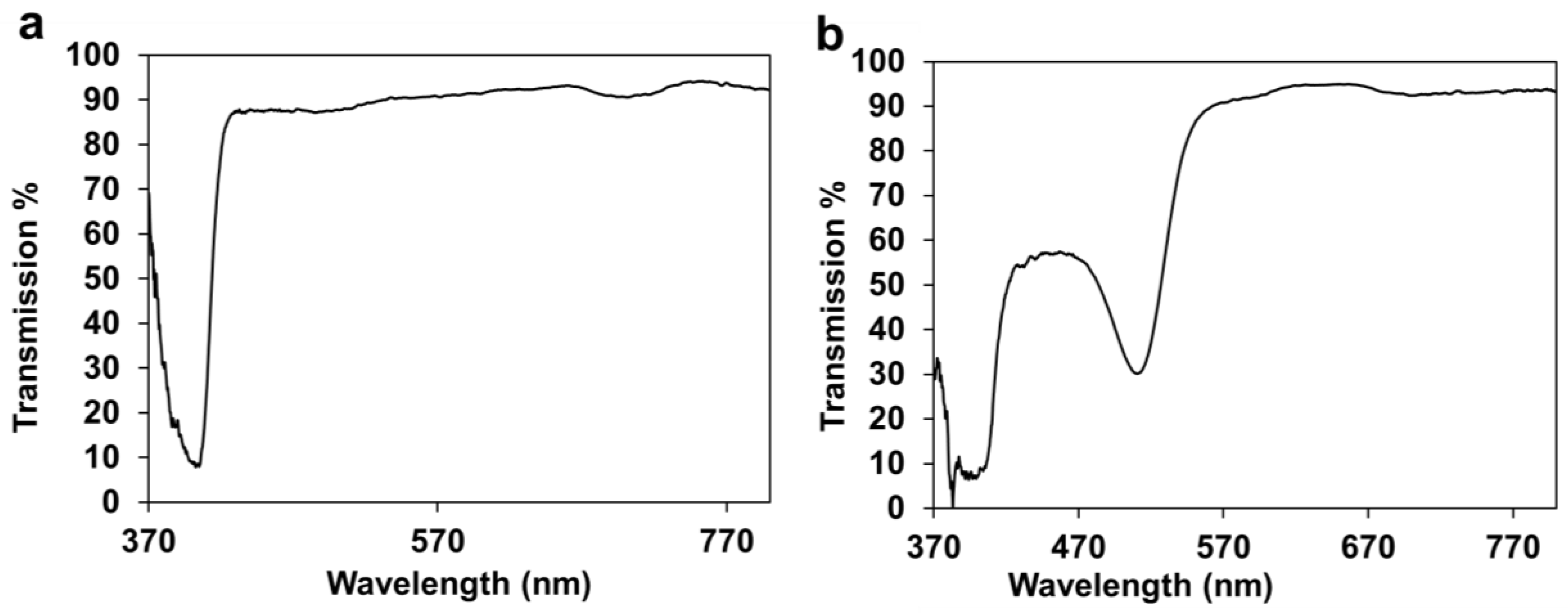
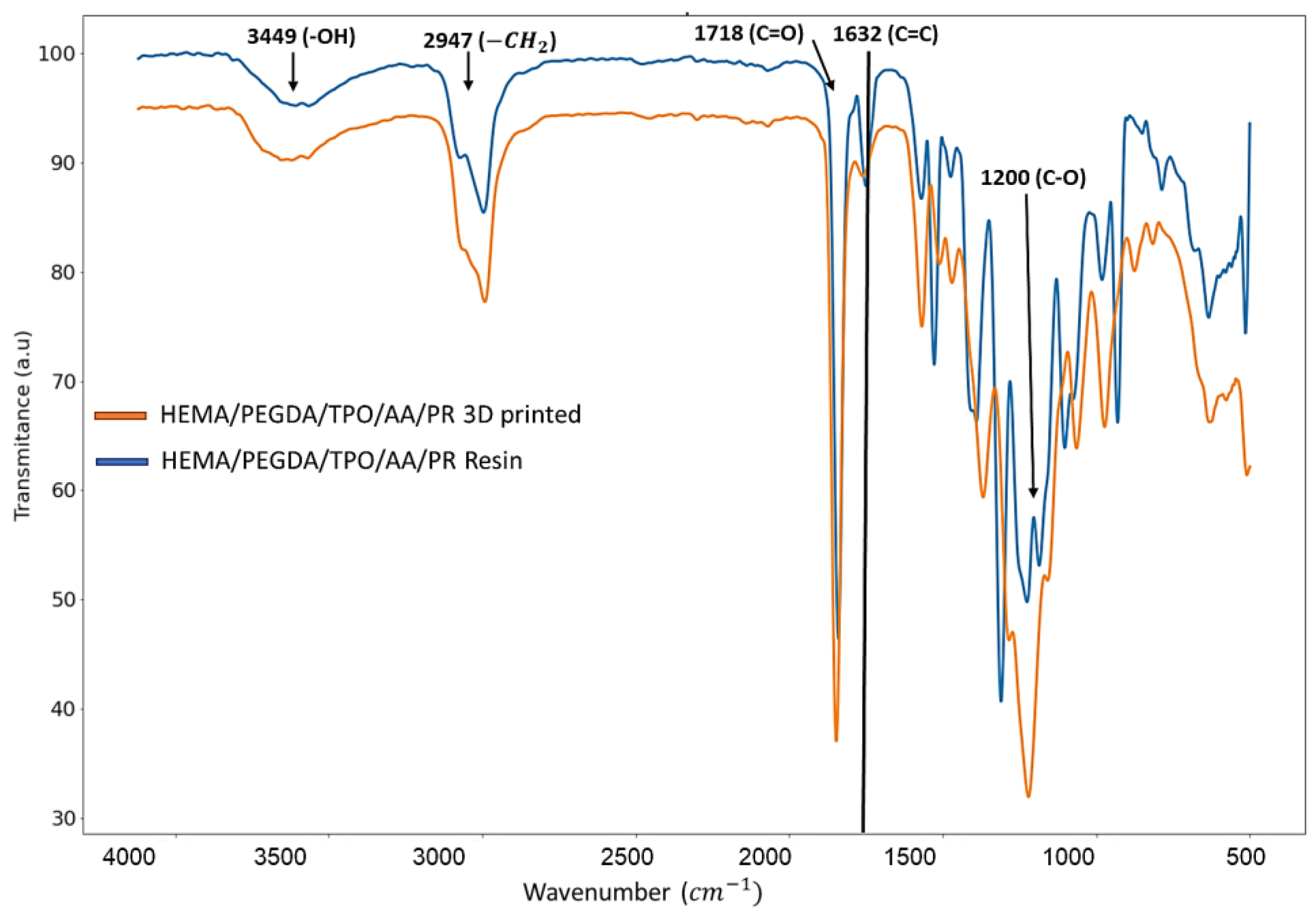
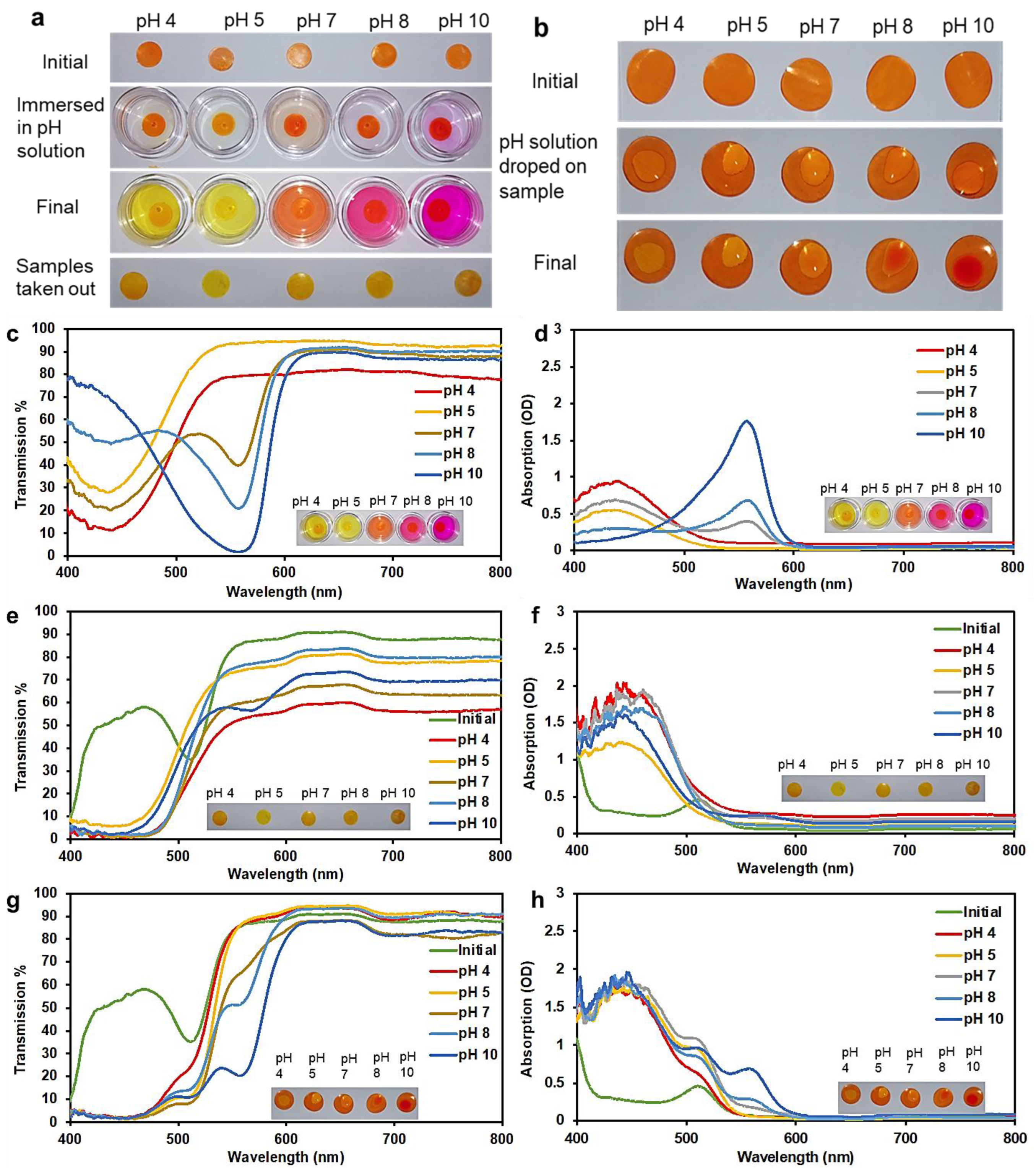


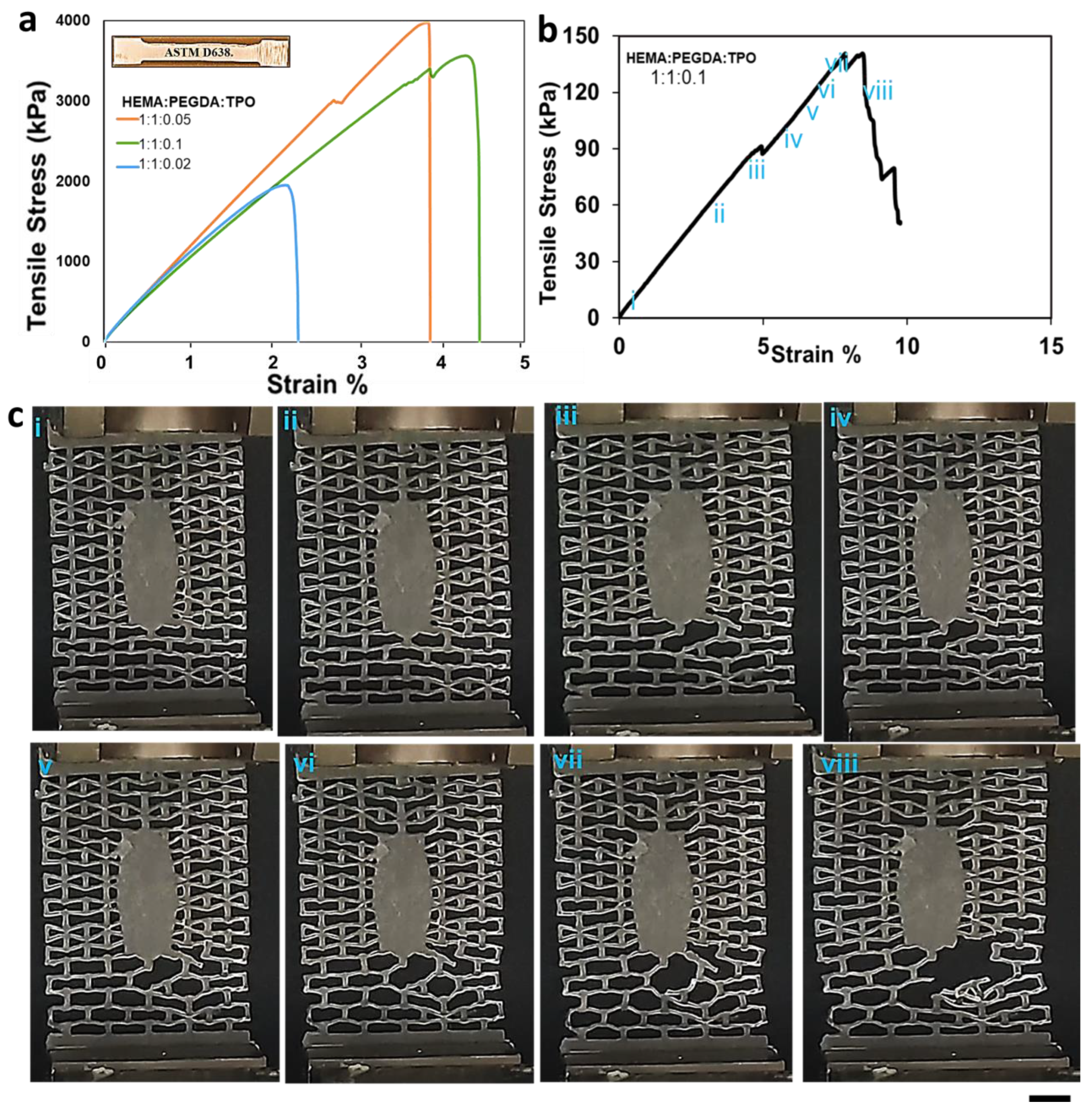
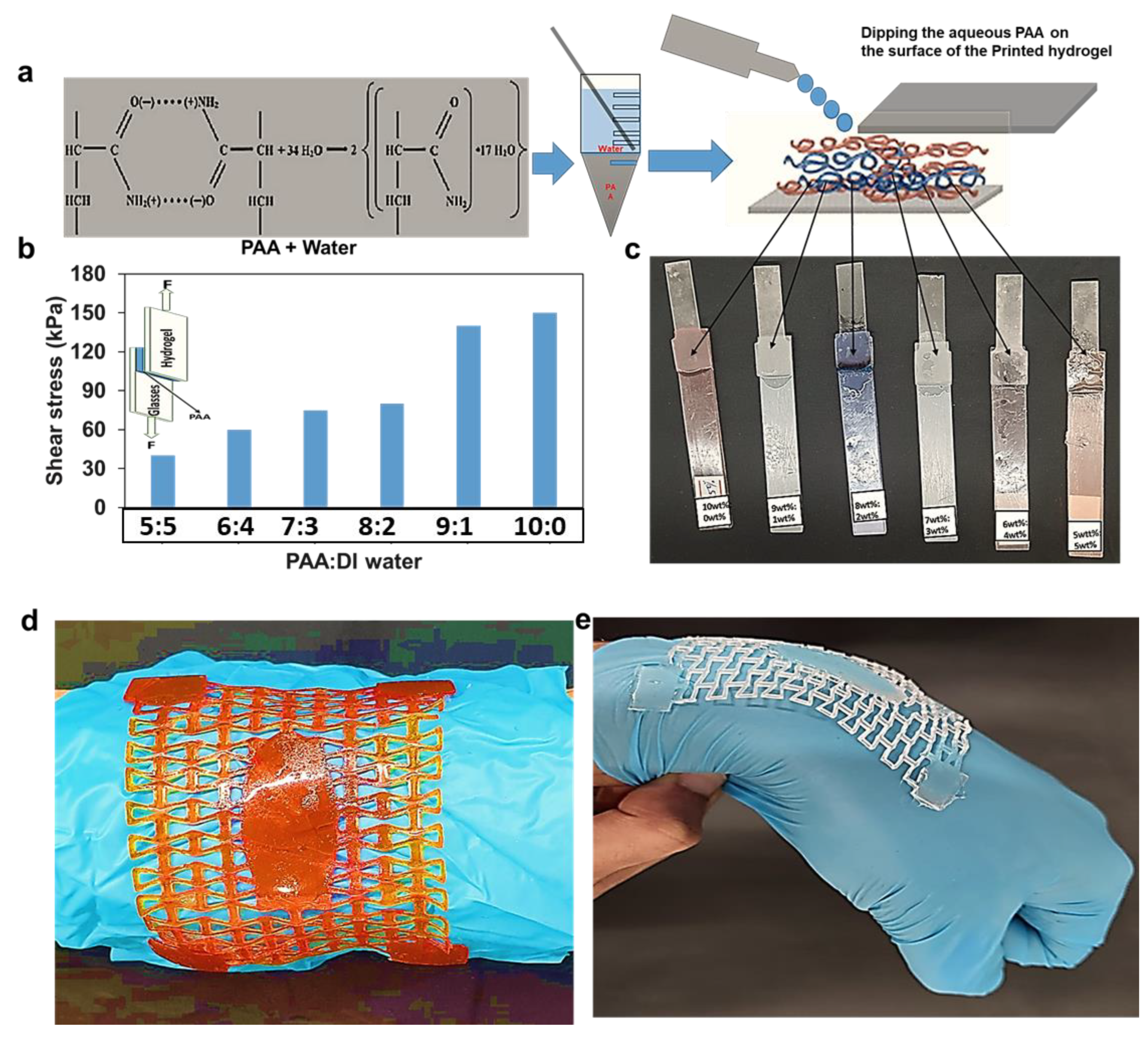

| Polymer Ratios (HEMA:PEGDA:TPO) | Tensile Strength (MPa) | Young’s Modulus (MPa) | Failure Strain (%) |
|---|---|---|---|
| 1:1:0.02 | 2.9 | 11 | 2.1 |
| 1:1:0.05 | 4.0 | 112.5 | 3.8 |
| 1:1:0.1 | 3.5 | 78.9 | 4.5 |
Disclaimer/Publisher’s Note: The statements, opinions and data contained in all publications are solely those of the individual author(s) and contributor(s) and not of MDPI and/or the editor(s). MDPI and/or the editor(s) disclaim responsibility for any injury to people or property resulting from any ideas, methods, instructions or products referred to in the content. |
© 2023 by the authors. Licensee MDPI, Basel, Switzerland. This article is an open access article distributed under the terms and conditions of the Creative Commons Attribution (CC BY) license (https://creativecommons.org/licenses/by/4.0/).
Share and Cite
Tsegay, F.; Hisham, M.; Elsherif, M.; Schiffer, A.; Butt, H. 3D Printing of pH Indicator Auxetic Hydrogel Skin Wound Dressing. Molecules 2023, 28, 1339. https://doi.org/10.3390/molecules28031339
Tsegay F, Hisham M, Elsherif M, Schiffer A, Butt H. 3D Printing of pH Indicator Auxetic Hydrogel Skin Wound Dressing. Molecules. 2023; 28(3):1339. https://doi.org/10.3390/molecules28031339
Chicago/Turabian StyleTsegay, Filmon, Muhammed Hisham, Mohamed Elsherif, Andreas Schiffer, and Haider Butt. 2023. "3D Printing of pH Indicator Auxetic Hydrogel Skin Wound Dressing" Molecules 28, no. 3: 1339. https://doi.org/10.3390/molecules28031339
APA StyleTsegay, F., Hisham, M., Elsherif, M., Schiffer, A., & Butt, H. (2023). 3D Printing of pH Indicator Auxetic Hydrogel Skin Wound Dressing. Molecules, 28(3), 1339. https://doi.org/10.3390/molecules28031339






